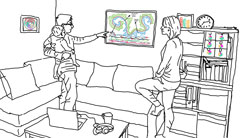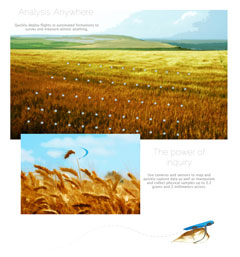Vis Futures
Design Fiction Methods for Envisioning Tomorrow’s Visualizations
☝️🚀 Submitted “Visualizations from the Future”. Click to see larger versions, or submit your own below!
Visualization Futures Workshop at IEEE VIS 2020
The goal of this workshop is to encourage and stimulate the use of design futuring in visualization for envisioning the next generation of vis tools and applications. Our objectives are to i) generate examples of visualizations from the future, and ii) generate methods for designing such visualizations, that other people can include in their teaching and/or practice of visualization.
The Vis Futures workshop will be part of IEEE VIS 2020 (October 26-30) and will be held online. The workshop will take place on Monday October 26, from 12:00PM to 3:30PM Mountain Time.
What to Expect
The workshop will examine how a variety of design ideation processes (including design fiction, speculative design, critical design, and more) can propel the visualization community to consider future applications of visualization and their impact. We intend to be inclusive of all design practices – incorporating a diverse range of playful and creative methods to envision future visualizations. We will also focus on identifying new ideation methodologies tailored specifically for visualization design. One possible tangible outcome will be to start the creation of a set of “Vis Futures” method cards – ideation prompts that can help designers envison and explore the visualizations of the future.
We will post more details on the exct format and length of the workshop over the summer as IEEE VIS finalizes their plans for an online conference. However the workshop will focus primarily on:
- Presentation sessions in which contributors exhibit and discuss their visualizations from the future and their implications for visualization research.
- Interactive design futuring activities and sessions devoted to curating an initial set of Vis Futures method cards.
Call for Participation
We encourage students, practitioners, researchers and hobbyists interested in design futuring methods and visualization to participate. We are looking for a broad participation from many disciplines and practices including design, arts, sciences, digital humanities, cartography and engineering to name a few.
We invite you to submit two types of work:
Visualizations from the Future
To set the tone for the workshop, we ask potential attendees to help us create new speculative designs for tomorrow’s visualizations. These submissions, inspired by Wired Magazine’s classic Artifacts from the Future, can be design fictions in the form of sketches, drawings, short videos, websites, pictures, or physical artifacts that depict specific examples of visualizations from the future, accompanied with a short text description. We will display accepted submissions in the gallery above and they will serve as source of inspiration during the workshop.
Submissions — Submit your Visualizations from the Future using this Submission Form. You will be asked to provide for each Visualization from the Future you submit:
- A title
- A brief (<500 character) description
- A primary image
- [optional] up to 10 additional images
- [optional] a link to additional material such as a website or a youtube video
Submissions should be your own work, but can include designs created for previous events, courses, or other design futuring venues. You can submit as many visualizations from the future as you wish and we encourage you to submit early and often!
Design Futuring Methods for Visualization
These submissions are in the form of a pictorial describing a (speculative) method for designing for the future. Such methods could be similar to existing design prompts like The Thing From the Future (a design futuring game not tailored to visualization) or the Five Design Sheet methodology (which is tailored to visualization but not a design futuring method).
Design Futuring Methods for Visualization must be formatted using the Pictorials format based on the VISAP Pictorials format. InDesign and Word templates are available along with the necessary fonts and it is mandatory to use this format. Pictorials for Design Futuring Methods for Visualization should typically be 2-4 pages long (although we do not enforce any strict page limit), and making use of any of the template pages, or combinations thereof. Pictorials heavily rely on visual description. See VISAP Pictorials for inspiration.
Submissions — Submit your Design Futuring Method for Visualization using this Submission Form. You will be asked to provide for each method you submit:
- A title
- A brief (<500 character) summary (i.e. the abstract for your submission)
- A PDF submission file following the Pictorials format as described above
- Information about how many people are needed to apply your Design Futuring Method for Visualization, what materials are needed, are there any type(s) of spaces needed and how long it takes to complete
Timeline
We accept submissions at any time. To encourage multiple submissions, provide feedback to authors rapidl, and continuously grow the gallery of visualizations from the futures on this website we will review submissions at three different times. The three deadlines for submitting your work are:
- July 31
- August 15
- August 31
- September 30
- October 20
Organizers
Charles Perin, University of Victoria
Wesley Willett, University of Calgary
Katherine Currier, University of Calgary
Lora Oehlberg, University of Calgary
Sheelagh Carpendale, Simon Fraser University


